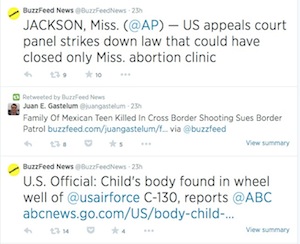
BuzzFeed is hiring product and editorial leads to build a new news app for the company, starting a team which will eventually include up to six editorial staffers. The app will focus solely on news as it unfolds online, differentiating it from BuzzFeed’s existing app, which is currently ranked sixth among free iPhone news apps.
“I think the main reason to download that [existing] app is to be entertained,” says BuzzFeed editor-in-chief Ben Smith. “There’s also, we think, people who want to have an app that’s primarily about telling them what’s going on in the world and what the big stories are. We felt like it made sense, given that we have this really strong news organization now, to really take advantage of that and build one.”
As the main architects of the new product haven’t yet been hired, Smith doesn’t have all the facts on what the news app will look like — but he does have a few ideas. For example, he’s not sure the traditional news story is the best format for sharing information in an app, a view frequently espoused by apps like Circa. In addition, push notifications are a top priority — Smith says he’s very interested in NBC News Digital’s Breaking News app.
But he also doesn’t want the content to sound like it was written by a robot, he says. “We’re planning on doing something that reaches a reader who wants something more than a list of what just happened,” he says. The challenge will be to create a content stream that’s interesting to the individual user while also delivering top headlines.
“There’s a general news audience of people who don’t want to know what’s happening every four minutes, but are informed, educated people who want to know what’s happening in the world — people who in some sense used to be known as daily newspaper subscribers,” says Smith. “They probably want their news a bit more than daily, and when something big happens, they want to know immediately, but are also looking for a trusted voice to help them navigate this incredibly noisy, messy social news web.”
To get a sense of what such a guide would look like, Smith plans to have the project’s editor start out by writing an email newsletter — he compared it to afternoon roundup email The Skimm. BuzzFeed will use the email product to sound out a voice for the new app while it’s being built. (Smith has an interesting way of defining the voice he’s looking for, writing in the job posting that applicants should “write in warm, clear, non-telegraphic English.”)
To get a sense of what to expect content-wise from the app, Smith says to look to Twitter. “If you look at the @BuzzFeedNews Twitter feed…it’s not trying to push BuzzFeed content. It’s trying to be a great feed for people who want to know what’s going on. I think that’s been very successful for us,” he says.
 Both the Twitter feed and the planned app are framed around the idea that there is a demand for better summarization in the current social news landscape. Smith believes that news organizations today have a responsibility to curate news feeds for their audiences that are separate from the central task of reporting and news production — a belief which will also inform his hiring decision.
Both the Twitter feed and the planned app are framed around the idea that there is a demand for better summarization in the current social news landscape. Smith believes that news organizations today have a responsibility to curate news feeds for their audiences that are separate from the central task of reporting and news production — a belief which will also inform his hiring decision.
“The pulse of news now is Twitter,” he says. “You need someone who really, deeply understand how news travels now and how to be both first and right with stuff — which is the perennial news challenge that everybody faces — and to be able to do that in that incredibly noisy ecosystem.”
Part of understanding that ecosystem means acknowledging that many readers don’t care what outlet their news comes from — they care about getting it quickly. When it comes to breaking news, Smith says, the team working on the app won’t wait for BuzzFeed to publish a story if someone else has a scoop. “I don’t think you can do news well if you think that your news organization produces the only content of value. That’s crazy,” Smith says. “There’s a humility required in doing news well now. It requires being open to the Internet, and realizing you’re a part of a collaborative project with other news outlets.”
BuzzFeed gets more than half of its total traffic from mobile. But a very small percentage of that traffic comes from their app — 3.2 percent in February 2014, according to Digiday. Despite that, Smith says the new app won’t be concerned with driving traffic.
“If it’s a story people are talking about and reading, we’re not going to try to push people to our aggregated version,” he says. “If it makes sense to summarize it in the stream, we might, but this isn’t about trying to steer people to BuzzFeed content. The app itself is the goal.”